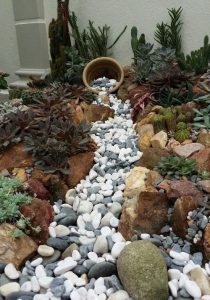Here are time-tested techniques that save you time and energy while still having a stunning yard.
- Automatic Irrigation System skips the maintenance of dragging a garden hose. These systems make watering your plants convenient and precise. Specific gardens are targeted for maximum efficiency. For travelers, your plants will never go thirsty when you are out of town.
- Container Gardens have multiple benefits that minimize plant maintenance. Watters Potting Soil significantly impacts a plant’s health for more robust roots and accessible care. You can control how much water and sunlight the containers receive. And pests and diseases are less likely to strike containers. Overall, you’re likely to spend less time dealing with plant problems. By moving your containers indoors for winter, you no longer have to replace plants each spring.
- Control Erosion by taking measures before erosion occurs. You can save yourself a lot of maintenance later. Select plants grown on slopes to hold back soil and avoid sucking up water. Creeping junipers and cotoneaster are commonly used for this purpose.
- Deer Resistant Ground Covers are an intelligent landscape solution reducing water and mowing time. Select plants that deer avoid, such as Creeping Mahonia, sweet woodruff and lamb’s ear. Watters Deer & Rabbit Resistance Plant List will help.
- Drought-Tolerant Perennials last many years. There’s nothing wrong with growing an annual plant that needs lots of water. Gardeners love the fragrance. They require work for one growing season’s enjoyment compared to drought-tolerant shrubs and perennials, especially in areas that receive full sun, which look great for years of enjoyment.
- Hardscaping is all the non-living landscaping components, including brick patios, concrete walkways, stone walls, wooden fences, pergolas and gravel beds. They certainly require less work than your plants in the yard. Trade some grass for a paved courtyard. You will add some usable outdoor living space and reduce your yard maintenance.
- Landscaping for Dogs can keep your yard from becoming ragged. Switch to grass that holds up under “paw traffic,” such as Tall Fescue grass. A clover lawn is also ideal because it won’t show the unsightly yellow stains or burns from canine urine, unlike typical grass.
- Low Maintenance Ornamental Grass is both beautiful and easy to care for. It fills gardens with texture, height, foliage colors, floral displays and more. Tall grass has a wide array of appearances and growing requirements, so you will find a species you like. Maiden grass is a hip-high grass that is both drought-tolerant and low maintenance. Likewise, Blue Fescue is a short, drought-tolerant variety with no serious problems with pests or diseases.
- Mulch is an unsung hero of the landscape. An application of mulch reduces water needs significantly by maintaining soil moisture and keeping garden soils from sunburn. It also suppresses weeds, making yard care much more effortless. A 2-3” inch layer of mulch protects plants through the winter rather than having to remove and replant them.
- Rock Gardens use drought-resistant plants that need little care. The rocks themselves are decor that never needs water or tending. Stones help keep weeds down while having a natural visual appeal. Ensure your plants are companions and have the same water and sun needs. That way, you won’t have to worry about providing individualized plant care.
- Trees significantly impact landscapes, providing essential focal points and shade. Some trees are better than others when minimizing maintenance. Look for trees that don’t drop messy seeds or fruit to reduce time cleaning up and preventing seedlings from growing in unwanted places. Consider dwarf trees like Purple Leaf Plum or Redbud, especially if the yard is small. These trees mature around 15 feet tall, making pruning a cinch. They are deciduous varieties that need minor leaf cleanup in autumn, compared to large trees.
- Xeriscaping is a landscape with plants that require minimal supplemental water once established, especially lawns. Maintaining a lawn is labor-intensive and costly when you consider water, lawn food and even replacing one that has succumbed to drought. Avoid this entirely by changing your landscape design with xeriscaping native plants found on our Yavapai Friendly Plant List (https://wattersgardencenter.com/wp-content/uploads/2017/01/Water-Bills-be-Gone-Plant-Guide.pdf).
Until next month, I’ll be helping gardeners here at Watters Garden Center. QCBN
By Ken Lain
Ken Lain can be found throughout the week at Watters Garden Center, 1815 Iron Springs Road in Prescott, or contacted through his website at WattersGardenCenter.com or Top10Plants.com.






Leave a Reply